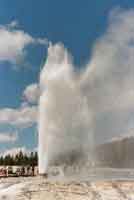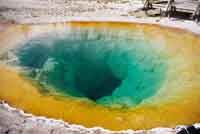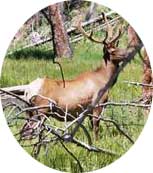
Dimdima
Online Children's Magazine from India

Dimdima
Online Children's Magazine from India

Como estas my friends? It's time for us to live dangerously once again. Join me on another ride into the wild. This time we will be visiting Yellowstone, the oldest National Park in USA. Established in 1872, Yellowstone spans about 2.2 million acres of land spread across the states of Montana, Idaho and Wyoming.  Most of the park area sits atop a huge volcanic basin. As a result of volcanic activity that has been going on for hundreds of years under the earth's crust, thermal features like geysers, hot springs, and sulfur holes are a common sight throughout the park. Tourists throng Yellowstone to gape awestruck at the bubbling springs and the hot jets of water shooting up from the ground at regular intervals. One geyser, affectionately called The Old Faithful, because it erupts once or twice every three hours, is a hot favourite among the tourists.
Most of the park area sits atop a huge volcanic basin. As a result of volcanic activity that has been going on for hundreds of years under the earth's crust, thermal features like geysers, hot springs, and sulfur holes are a common sight throughout the park. Tourists throng Yellowstone to gape awestruck at the bubbling springs and the hot jets of water shooting up from the ground at regular intervals. One geyser, affectionately called The Old Faithful, because it erupts once or twice every three hours, is a hot favourite among the tourists.
 Yellowstone Park is one of the oldest ecosystems of the world, and it is still intact. It is, therefore, a natural sanctuary for many species of endangered wildlife. Elk, deer, bison, bald eagles and grizzly bears roam these lands at will. Some lucky tourists may even spot a gray wolf or two.
Yellowstone Park is one of the oldest ecosystems of the world, and it is still intact. It is, therefore, a natural sanctuary for many species of endangered wildlife. Elk, deer, bison, bald eagles and grizzly bears roam these lands at will. Some lucky tourists may even spot a gray wolf or two.
While touring the park, the Elk is an animal you are most likely to come across. Elks are spotted throughout the year. The male elk is usually a loner and prefers to wander alone, but the females and calves are social animals. They travel in large groups and graze on grass or twigs. The males are often as big as horses, and they look just as majestic. The huge antlers on their heads set them apart from the deer and other similar animals that inhabit the park. During the mating season, males lock horns and fight to win the favor of a group of females. This mating ritual is an awesome sight to behold. The elks, however, live in mortal fear of predators like the Grizzly Bear and the Gray Wolf.
The Grizzly Bear is a natural enemy of the elks. A grizzly bear weighs anywhere between 300 and 600 pounds. These animals are surprisingly agile despite their girth. They eat both plants and animals, and can be recognized by the hump on their shoulders. Their fur is lighter than that of the Black Bear. Oftentimes the fur is flecked with silver tips or "grizzles." Human encroachment into their natural habitat caused the decline of this species in the mid-1900s. Recognizing the seriousness of the situation, these bears were placed on the endangered species list in 1975. Today, the Yellowstone area is home to a large number of grizzlies.
The Gray Wolf is another animal that fell prey to hunters. Somewhere around the late 1800s and early 1900s, their numbers fell alarmingly. Wildlife conservationists, therefore, embarked on a bold plan to ensure the continuation of the species. They bred gray wolves in captivity and then released them into the Yellowstone Park a few years ago. The animals thus were reintroduced into their natural ecosystem. Gray wolves are social animals. They travel in packs and hunt to survive in the wild. Scientists refer to the "parent" wolves as the alpha pair of the pack. The beta wolves follow the alpha pair in importance. The youngest or least important member of the pack is referred to as the omega wolf. The wolves communicate with each other using howls, yips, growls and barks.
Park authorities never tire of warning that we, tourists are only "guests" or "visitors" of this large biological unit. Since the animals fear human beings instinctively, they might attack us, and are, therefore, quite dangerous. It is against the law for tourists to get within 100 feet of bears and other endangered species. Picking wild flowers and collecting archeological samples is also frowned upon. It is up to all of us to protect this historical legacy and preserve it for the enjoyment of future generations.
I've had a lot of fun exploring the famous Yellowstone Park today. I promise to line up another adventure for you within the next couple of weeks. Until then…Adios, from your amiga in Arizona!
Notes:
Como Estas? : Spanish for "How are you?"
Geyser: A stream that shoots hot jets of steam into the air.
Ecosystem: A natural community of organisms living together in a natural environment.
Alpha: First letter of the Greek alphabet.
Beta: Second letter of the Greek alphabet.
Omega: Last letter of the Greek alphabet.
Adios: Spanish for "Goodbye".
Amiga: Female friend
Dimdima is the Sanskrit word for ‘drumbeat’. In olden days, victory in battle was heralded by the beat of drums or any important news to be conveyed to the people used to be accompanied with drumbeats.
Bharatiya Vidya Bhavan
K. M Munshi Marg,
Chowpatty, Mumbai - 400 007
email : editor@dimdima.com
Bharatiya Vidya Bhavan
505, Sane Guruji Marg,
Tardeo, Mumbai - 400 034
email : promo@dimdima.com
Dimdima.com, the Children's Website of Bharatiya Vidya Bhavan launched in 2000 and came out with a Printed version of Dimdima Magazine in 2004. At present the Printed Version have more than 35,000 subscribers from India and Abroad.